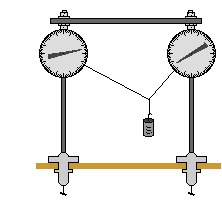| Sir Isaac Newton |
So it all started
out with Newton
sitting under an
apple tree ....... 1. INERTIA: "An object at rest stays at rest and an object in motion stays in motion with the same speed and in the same direction unless acted upon by an unbalanced force."
(Inertia is the tendency of an object to resist changes in its state of motion.)
2. F = MA: "The acceleration of an object depends directly upon the force acting upon the object, and indirectly upon the mass of the object."
As the force acting upon an object is increased, the acceleration of the object is increased. As the mass of an object is increased, the acceleration of the object is decreased.
3. For every action, there is an equal and opposite reaction.
3. For every action, there is an equal and opposite reaction.
Equilibrium, inclines, pulleys, and trains.
Assumptions:
- no friction
- no friction
- positive axes
- a = 0 (ax = 0 and ay =0, there is no movement in the x axis or y axis)
- a = 0 (ax = 0 and ay =0, there is no movement in the x axis or y axis)
INCLINES
STATIC:When the object is not moving while on an incline. Static friction is preventing motion on a stationary object.
Assumptions:
- a = 0
- Fn is perpindicular to surface
- positive axes in the direction of acceleration
- no air resistance
- static friction = coefficient of static friction x normal force
- μ = tanΘ
KINEMATIC:
When the object is moving down an incline. The kinematic friction is working against the moving motion.
Assumptions:
- ax ≠ 0, ay = 0 (because it is moving in the x axis)
- positive axes in direction of acceleration
- Fn is perpindicular to surface
- no air resistance
- kinetic friction = coefficient of kinetic friction times normal force
PULLEYS
When objects are held by pulleys.
Assumptions:
- frictionless pulleys + rope
- no air resistance
- multiple FBDs
- positive axes in direction of acceleration
- T1 = T2
- acceleration of system is the same
Assumptions:
- 1 FBD for acceleration
- 3 FBDs for T1 & T2
- 1 FBD for acceleration
- 3 FBDs for T1 & T2
- no air resistance
- weightless cables
- positive axes in direction of acceleration
- ay = 0
- a is consistent
- weightless cables
- positive axes in direction of acceleration
- ay = 0
- a is consistent
And remember that for each problem,
BREAK DOWN THE X and Y COMPONENTS and SET YOUR POSITIVE AXES.






No comments:
Post a Comment